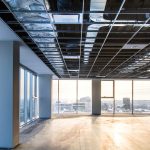The field of interior design can be divided into various categories based on focus and specialization. The most distinctive contrast is between residential and commercial interior design. Separating the two defined design spaces isn’t as easy as it may appear.
Defining Design Spaces
Simply stated, residential interior design projects often range from designing the interiors of a new construction home to redesigning the interior of an existing home.
Commercial interior design projects include commercial spaces like:
- Banks
- Offices
- Schools
- Hospitals
- Insurance
- Industrial
Commercial design categories can include market specialized design elements like government, technology, medical, retail, manufacturing, historic, or sustainable buildings.
Ascertaining spatial needs
In addition to the simple distinction of living vs. work spaces, residential and commercial design scope is largely based on needs. The needs of the client and the industry parameters for the interior designer can differ depending on whether the building is residential or commercial. Clients in residential design are individuals or families, and the designer has to take into account the client’s personal needs and desires while designing living spaces.
Designers who usually work in homes may specialize in a particular area of residential design like kitchens, bathrooms, home offices, custom furniture, specialized work spaces, and home appliance design. Most people want their homes to be reflective of their own personal tastes and expressions of personal uniqueness.
For commercial design, the design inspiration comes from the corporate brand image and the design constraints are often tied to functional space limitations and commercial building code requirements. There is still a distinctive, personalized aim in commercial projects, but it often involves different textures, colors, and layout than is found in many residential settings.
Commercial functionality and brand image
The client for a commercial design is usually a corporation or organization in a commercial or industrial building. The designer has to make sure the building is functional reflecting the company’s image and brand. If creating a new hotel or restaurant for example, the design should make a statement about the business. Incorporating a design plan that is built on a vision and impression platform is the foundation for corporate and industrial designs.
Designers in both commercial and residential design, fashion and plan more appealing and productive spaces by creating spaces mindful of safety regulations. Though the code requirements are vastly different, the intent of the code will force creative design elements and likely direct the final “feeling” of a space.
Working with us
As a professional commercial design team, we work specifically with commercial clients. We understand busy schedules. Our client-focused commitment ensures a collaborative process, respectful of budgets and deadlines, as it delivers effective design solutions as inspiring as they are beautiful.
What really counts is the value our professional design team brings to making all spaces safe, comfortable, attractive and functional for every visitor to the space.
About Us
At InteriorLOGIC, we build work environments. From our home office in Madison, WI our award-winning commercial interior design team focuses on creating spaces that work. We continually work to improve the end user experience with each design and our team is well-suited for challenging projects including LEED certification and sustainability projects. For more information about our business and approach, please visit www.intlogic.com.




